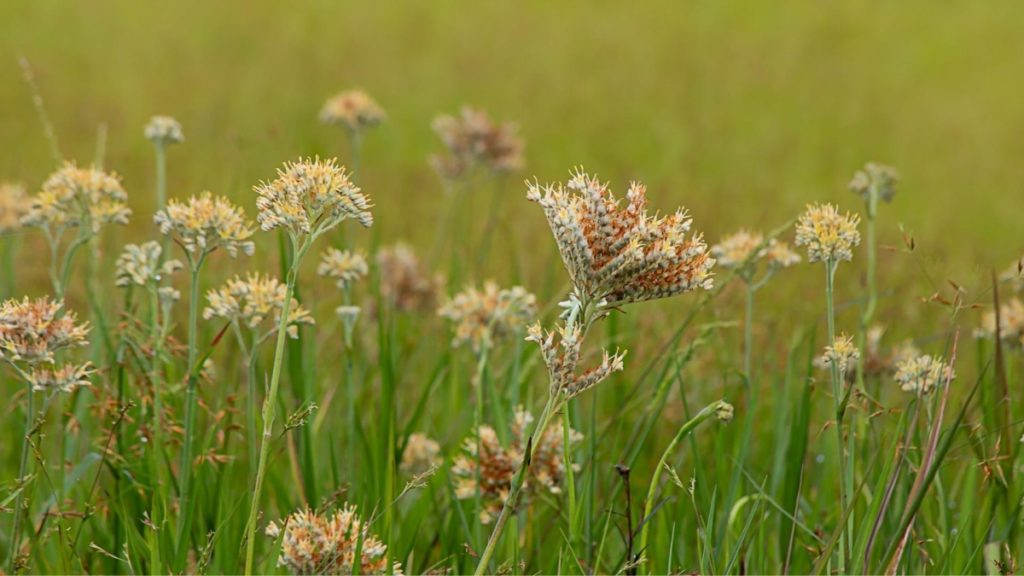
The prairies cover a large territory, from parts of Canada, South to Texas. This vast land has a wade variety of native flowers and you may need to do some research to find some natives you are happy with and will survive What nature dishes out.
Can you imagine this… When the first European settlers crossed into what is now “The Great Plains,” they were probably astonished by what they saw. Landscapes that resembled the Savannas of Africa with large trees dotting the grasslands. When they looked upon hundreds of miles of only grasslands, the best name they could find for this alien environment was prairie, (the French word for meadow).
We now know that this vast Meadow has a complex ecosystem that suits the specific requirements of living on what we have come to call the Great Plains. The flora of these grasslands exists under an extreme variety of topographic, moisture and soil conditions. Understanding these conditions will aid in the preservation and proliferation our native species. It is hoped that the re-introduction to native flora will be the start of a deeper appreciation and understanding of this now rare and valuable resource.
Plants and wildlife in this part of the United States have to be tough enough to survive everything nature can dish out. From triple digit highs to sub zero temperatures and everything in between. Droughts, floods, tornadoes, drought, floods and other weather conditions that can bless or punish this land. Toss in various soils or growing conditions and you have a variety of growing conditions.
- Xeric- Somewhat excessively drained and excessively drained soils; usually are sand or soils containing rock or gravel.
- Mesic- Moderately well drained and well drained soils are soils that neither dry out nor tend to flood.
- Hydric- Imperfectly or poorly drained soils are those from which water is removed so slowly that the soils are saturated and water remains at or near the surface for long periods of time.
These soil types along with slope conditions will determine which plants to choose for your planting. If you are inventive or industrious, several different sets of conditions can be created. You can build a low wet area or bog by borrowing soil from an area or impounding water. You can create a dry area by hauling in sand, rock or even larger pieces of limestone).
Your method of site preparation will be dependent on your soils and topography, previous land use, equipment and available time. Before you begin, take time to walk your site and determine what you would like to accomplish with your planting. Do you want some wildlife cover, flower garden, landscaping, erosion control?
Whatever your end result is to be, from a pre settlement representation to a low maintenance flower garden, have a preliminary plan in mind before you start. Try to select your site the fall before you intend to plant. This will allow you to begin eliminating preparing a plan and perhaps collecting seed.
Prairie plants will do quite well on a variety of soil types without adding fertilizer. In fact, the use of fertilizer is discouraged especially during the initial establishment phase. Fertilization will only provide nutrients for competitive weeds that slow the establishment of your prairie planting.
You may want to attract birds, butterflies and other wildlife, or just do your part to help restore the native land. Be sure to check out other regions, as many native flowers cross over region to region. Now here are a few native flowers for you to look at.
Penstemon digitalis
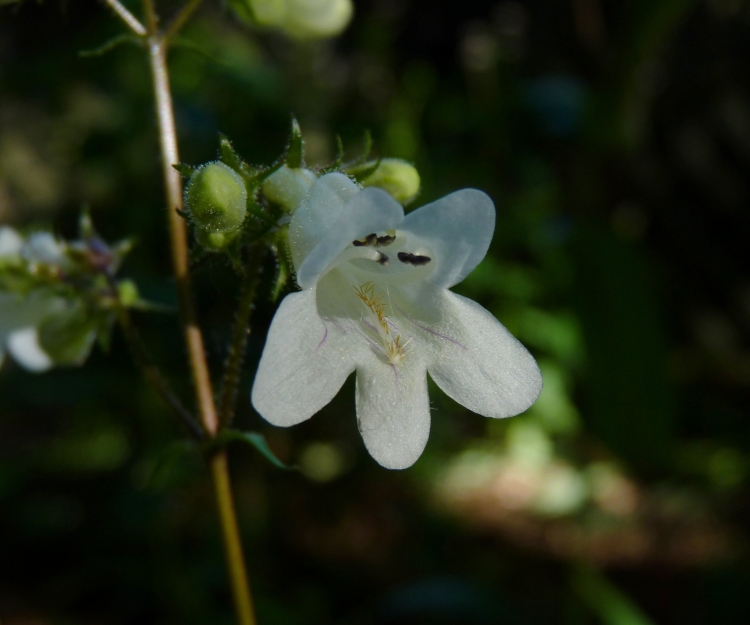
- Common Name: beard tongue
- Zone: 3 to 8
- Plant Type: Herbaceous perennial
- Family: Scrophulariaceae
- Native Range: Eastern United States to North Dakota and Oklahoma.
- Height: 3 to 5 feet
- Spread: 1.5 to 2 feet
- Bloom Time: April – June
- Bloom Color: White
- Sun: Full sun
- Water: Dry to medium
- Maintenance: Medium
General Culture
Grow in average, dry to medium moisture, well-drained soil in full sun. Avoid wet, poorly drained soils.
Noteworthy Characteristics
This penstemon is a clump-forming perennial which typically grows 3-5′ tall and occurs in prairies, fields, wood margins, open woods and along railroad tracks. Features white, two-lipped, tubular flowers (to 1.25″ long) borne in panicles atop erect, rigid stems. Flowers bloom mid-spring to early summer. Basal leaves are elliptic and stem leaves are lance-shaped to oblong. Penstemon in Greek means five stamens (four are fertile and one is sterile). Penstemon is sometimes commonly called beard tongue because the sterile stamen has a tuft of small hairs.
Problems
No serious insect or disease problems. Root rot can occur in wet, poorly-drained soils. Leaf spots are occasional problems.
Uses
Mass in sunny borders, wild gardens, native plant gardens or naturalized areas. One of the more hardy Penstemons. Attracts butterflies and birds.
Penstemon cobaea
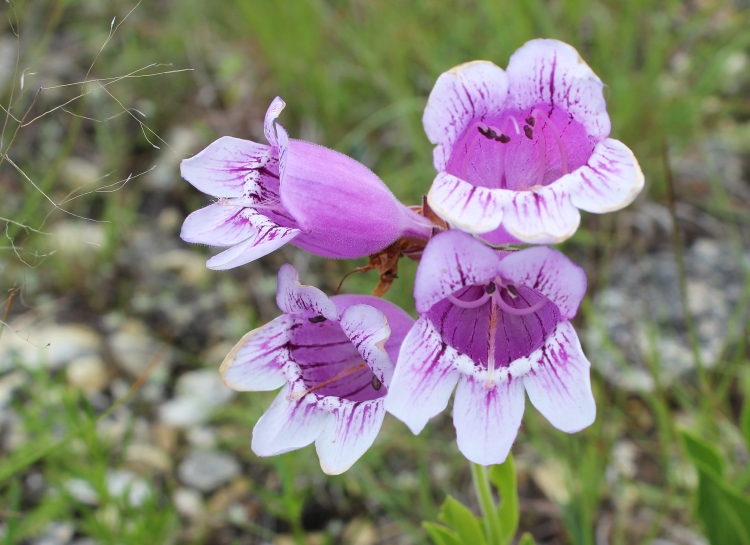
- Common Name: dew flower
- Zone: 5 to 8
- Plant Type: Herbaceous perennial
- Family: Scrophulariaceae
- Native Range: South-central United States To South Dakota and Oklahoma
- Height: 1 to 2 feet
- Spread: 1 to 1.5 feet
- Bloom Time: May
- Bloom Color: White, pink to violet
- Sun: Full sun
- Water: Dry to medium
- Maintenance: Low
- General Culture:
- Easily grown in average, dry to medium, well-drained soil in full sun. Avoid wet, poorly-drained soils.
Noteworthy Characteristics
This penstemon is a clump-forming perennial which occurs on prairies, limestone glades and rocky bluffs. Typically grows 1-2.5′ tall. Features loose, terminal panicles of white to violet to deep purple, 2″ long, tubular flowers atop erect, rigid, downy stems. Flowers bloom in mid-spring and are somewhat larger than most penstemons. Downy, clasping, lance-shaped upper leaves. Sometimes commonly called beard tongue because the sterile stamen has a tuft of small hairs.
Problems
No serious insect or disease problems. Root rot can occur in wet, poorly-drained soils.
Uses
Sunny borders, rock gardens, native plant gardens and wild gardens. Attracts butterflies and hummingbirds and other birds for seed.
Liatris pycnostachya
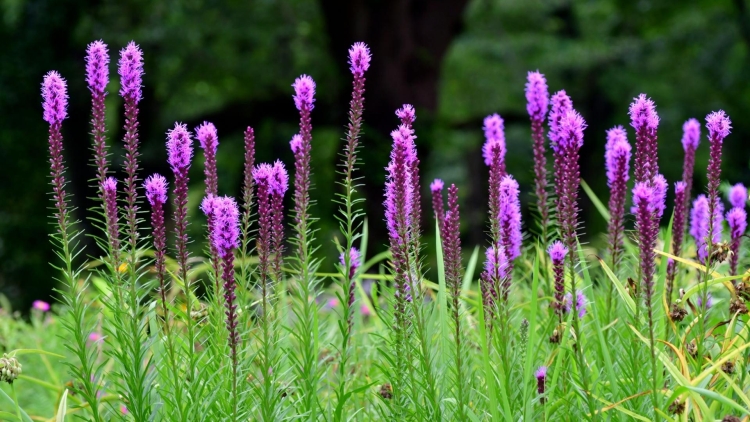
- Common Name: prairie blazing star
- Zone: 3 to 9
- Plant Type: Herbaceous perennial
- Family: Asteraceae
- Native Range:: Central and southeastern United States
- Height: 2 to 5 feet
- Spread: 1 to 2 feet
- Bloom Time: July – August
- Bloom Color: Lilac-purple
- Sun: Full sun
- Water: Dry to medium
- Maintenance: Low
- Attracts birds, hummingbirds and butterflies.
- It also is a wonderful cut flower.
General Culture
Easily grown in average, dry to medium, well-drained soils in full sun. Tolerant of poor soils, drought, summer heat and humidity. Intolerant of wet soils in winter. Sometimes treated as a biennial.
Noteworthy Characteristics
Prairie blazing star is perhaps the tallest Liatris species in cultivation, typically growing 2-4′ tall (infrequently to 5′). It is an upright, clump-forming, commonly occurs in prairies, open woods, meadows and along railroad tracks and roads. Features rounded, fluffy, deep rose-purple flower heads (each to 3/4″ across) which are crowded into terminal spikes (to 20″ long) atop thickly-leafed, rigid flower stalks. Stalks arise from basal tufts of narrow, lance-shaped leaves (to 12″ long). Flowers generally open top to bottom on the spikes. Blooms in summer. Liatris belongs to the aster family, with each flower head having only fluffy disk flowers (resembling “blazing stars”) and no rays. Pycnostachya means “crowded” in Greek, in probable reference to the arrangement of both flower heads and leaves. This species is distinguished from other Liatris species by its reflexed, long-tipped involucral bracts.
Problems
No serious insect or disease problems. Flower spikes usually will need staking.
Uses
Perennial borders, cutting gardens, wild gardens, native plant gardens, naturalized areas, prairies or meadows. Some consider this species almost too tall (and somewhat unmanageable) for the border.
Helianthus divaricatus
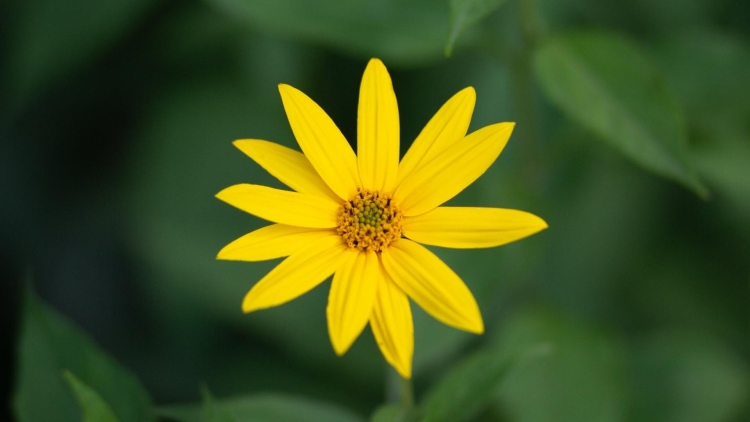
- Common Name: sunflower
- Zone: 3 to 8
- Plant Type: Herbaceous perennial
- Family: Asteraceae
- Native Range: Eastern United States, Great Plains, Canada
- Height: 2 to 6 feet
- Spread: 1 to 3 feet
- Bloom Time: July – September
- Bloom Color: Yellow rays with darker yellow center disk
- Sun: Part shade
- Water: Dry to medium
- Maintenance: Low
- Showy flowers attract birds and butterflies.
General Culture
Easily grown in average, dry to medium, well-drained soil in part shade. Tolerant of wide range of soil conditions. Spreads over time by creeping rhizomes to form colonies. Divide every 3-4 years to control invasiveness and maintain vigor.
Noteworthy Characteristics
This sunflower species is a native plant that occurs in open rocky woodlands and thickets. Features 2″ wide sunflowers with bright yellow rays and slightly darker yellow center disks atop rigid stems typically growing 2-6′ tall. Smooth stems and sessile or short-stalked leaves (to 6″) are the distinguishing characteristics of this species. Blooms from mid summer to fall.
Problems
No serious insect or disease problems. Taller plants may need staking.
Uses
Partially shaded border, wild or native plant garden, or naturalized planting. Attracts butterflies and birds (especially goldfinches). Similar to its cousin Heliopsis helianthoides.
Dalea purpurea
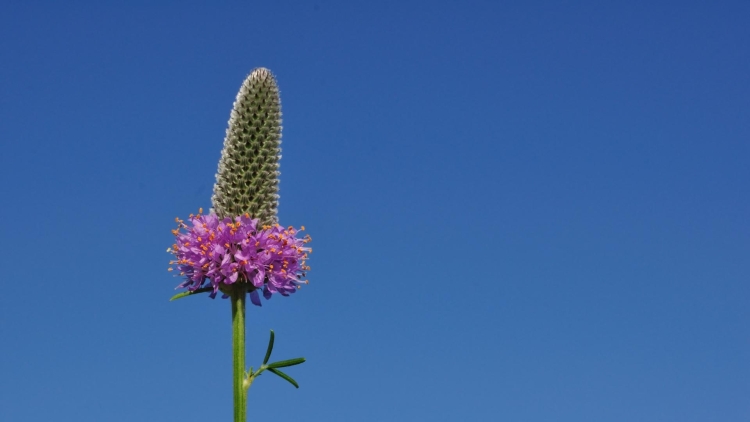
- Common Name: purple prairie clover
- Zone: 3 to 8
- Plant Type: Herbaceous perennial
- Family: Fabaceae
- Native Range: Eastern and central United States
- Height: 1 to 3 feet
- Spread: 1 to 1.5 feet
- Bloom Time: June – August
- Bloom Color: Rose/Purple
- Sun: Full sun
- Water: Medium
- Maintenance: Low
- Attracts bees and butterflies.
General Culture
Easily grown in average, medium, well-drained soils in full sun. Thick and deep taproot enables this plant to tolerate drought well. May self-seed in optimum growing conditions.
Noteworthy Characteristics
Purple prairie clover is a native which occurs in glades, rocky open woods and prairies throughout. Typically grows 1-3′ tall, it features tiny purple flowers in dense, cone-like heads (to 2″ long) atop erect, wiry stems in summer. Compound, odd-pinnate leaves, with 3-5 narrow linear leaflets. A nitrogen-fixing plant that is an important component of Midwestern prairie restorations.
Problems
No serious insect or disease problems.
Uses
Rock gardens, borders, native plant gardens, wild gardens, prairie or naturalized areas.
Coreopsis lanceolata
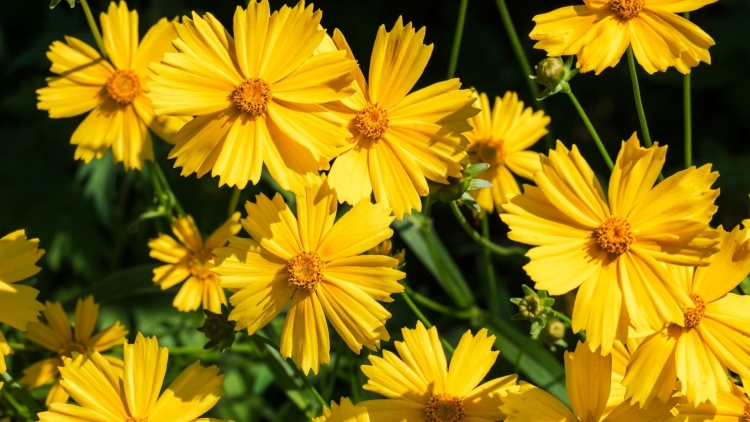
- Common Name: tickseed
- Zone: 4 to 9
- Plant Type: Herbaceous perennial
- Family: Asteraceae
- Native Range: Central and southeastern United States
- Height: 1 to 2 feet
- Spread: 1 to 1.5 feet
- Bloom Time: May – July
- Bloom Color: Yellow
- Sun: Full sun
- Water: Dry to medium
- Maintenance: Medium
- Attracts birds and butterflies.
- Many excellent cultivars of this species are available in commerce.
General Culture
Easily grown in dry to medium moisture, well-drained soil in full sun. Thrives in poor, sandy or rocky soils with good drainage. Tolerant of heat, humidity and drought. Prompt deadheading of spent flower stalks encourages additional bloom and prevents any unwanted self-seeding. Freely self-seeds, and in optimum growing conditions will naturalize to form large colonies. Plants may be cut back hard in summer if foliage sprawls or becomes unkempt. If grown in borders, division may be needed every 2-3 years to maintain robustness.
Noteworthy Characteristics
Lanceleaf coreopsis is a native wildflower which typically grows to 2′ tall and occurs in prairies, glades, fields and roadsides. Features solitary, yellow, daisy-like flowers (1-2″ diameter) with eight yellow rays (toothed at the tips) and flat yellow center disks. Flowers bloom atop slender, erect stems from spring to early summer. Narrow, hairy, lance-shaped leaves (2-6″ long) appear primarily near the base of the plant in basal tufts. Lower basal leaves are mostly entire, while smaller stem leaves may be pinnately lobed. Plants in the genus Coreopsis are sometimes commonly called lanceleaf tickseed in reference to the resemblance of the seeds to ticks.
Problems
No serious insect or disease problems. Can be an invasive self-seeder. Tends to sprawl, particularly if grown in moist and/or fertile soils. Crown rot may occur if grown in moist, poorly drained soils.
Uses
Best naturalized in native wildflower gardens, meadows or prairies. Good plant for areas with poor, dry soils. Can be effective in borders, but self-seeding tendencies must be kept in check.
Verbena hastata
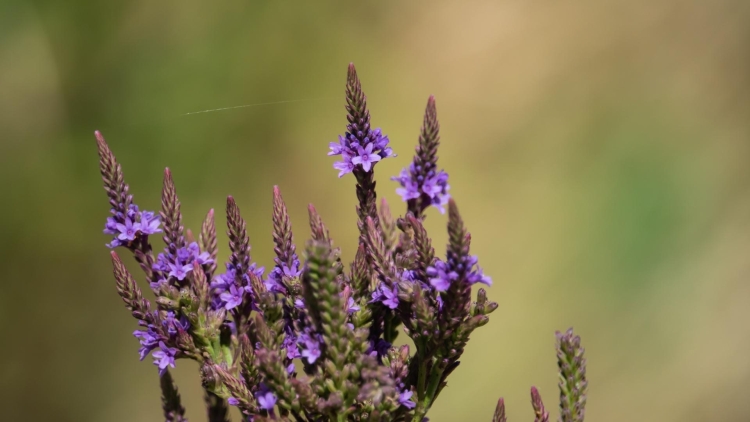
- Common Name: American blue vervain
- Zone: 3 to 8
- Plant Type: Herbaceous perennial
- Family: Verbenaceae
- Native Range: Prairie and Eastern North America
- Height: 2 to 6 feet
- Spread: 1 to 2.5 feet
- Bloom Time: July – September
- Bloom Color: Purplish-blue
- Sun: Full sun
- Water: Medium to wet
- Maintenance: Low
- Attractive to butterflies, bees and seeds for birds.
General Culture
Easily grown in average, medium to wet soils in full sun. Typically forms colonies in the wild by both thick, slowly spreading rhizomes and self-seeding. May self-seed in gardens in optimum growing conditions.
Noteworthy Characteristics
Blue vervain is a perennial which commonly occurs in wet meadows, wet river bottomlands, stream banks, slough peripheries, fields and waste areas throughout the prairies. It is a rough, clump-forming perennial with a stiff, upright habit which typically grows 2-4′ tall (less frequently to 6′) on square hairy stems which typically branch above. Features candelabra-like inflorescences of erect, slender, pencil-like spikes (2-6″ long) of tiny, tubular, 5-lobed, densely-packed, purplish-blue flowers (1/8″ wide) which appear over a long July-September bloom period. Flowers on each spike bloom bottom to top, only a few at a time. Lance-shaped, sharply toothed, green leaves (to 6″ long).
Problems
No serious insect or disease problems.
Uses
Borders, meadows, prairies, native plant gardens or informal/naturalized areas.
Several species of Prairies flowers and their cultivars could fill your pallet with colors, size and hardiness. It is just a matter of you looking and learning as to what is native and what you want. There are several species of milkweed (Asclepias) to choose from to attract Monarchs and other butterflies. Hyssops (Agastache — pronounced ag-ah-stak-ee) attract hummingbirds and are deer resistant as well.
Our native plants offer beauty and a toughness that introduced species can’t match. If your local garden centers offer little in the way of natives, get a hold of your county extension office or check online. You will be amazed at the wide variety and diversification in North American plants. Be sure to look at surrounding regions for plant ideas, as many native plants cross regions and even the continent.
